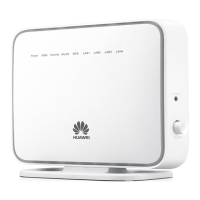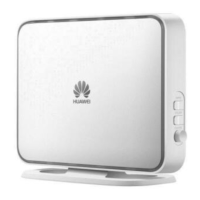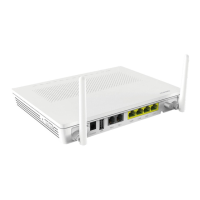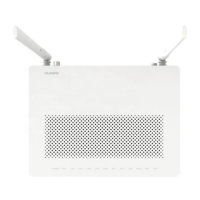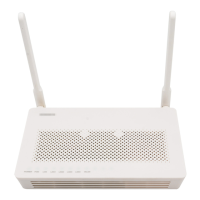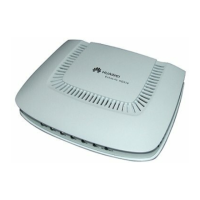Do you have a question about the Huawei ePico3801 and is the answer not in the manual?
Document outlines specifications, application scenarios, and configuration of the ePico3801.
Lists the product name and version associated with this document.
Identifies system engineers, maintenance engineers, and network administrators as the target readers.
Outlines the document structure by listing chapter titles and brief descriptions.
Indicates the initial release version and date of the document.
Explains the ePico3801's role in the uBro solution network architecture.
Details the ePico3801's capabilities, including enhanced indoor coverage and HSPA support.
Describes the physical components of the ePico3801, including its body and power adapter.
Covers RF, performance, physical, and environmental specifications of the device.
Illustrates typical use cases for the ePico3801 in various indoor environments.
Provides steps for accessing the ePico WebUI interface for device configuration.
Guides on configuring the ePico3801 via WebUI for PPPoE or static IP network modes.
Details prerequisites, required resources, and step-by-step procedures for ePico3801 commissioning.
Explains how to check the hardware status of the ePico3801, primarily through LED indicators.
Describes methods to verify network transmission between ePico3801 and other network elements.
Guides on how to check the software version of the ePico3801.
Outlines procedures for monitoring the ePico3801's operational status.
Details how to test basic CS and PS services provided by the ePico3801.
Lists and describes the communication ports available on the ePico3801.
Explains configuring automatic network planning parameters via AP Manager for optimal radio environment.
Details manual configuration of ePico cell parameters like status, frequency, and maximum TX power.
Guides on adjusting automatic pilot adjustment parameters to effectively reduce interference.
Covers adjusting parameters for cell reselection and handover to macro network cells.
Details adjustments for basic functions like HSPA status, emergency call redirection, and location modes.
Lists routine checks for equipment surface, cleanliness, and LED status.
Provides procedures for powering the device on and off, including LED status checks.
Details the step-by-step process for replacing a faulty ePico3801 unit.
Document outlines specifications, application scenarios, and configuration of the ePico3801.
Lists the product name and version associated with this document.
Identifies system engineers, maintenance engineers, and network administrators as the target readers.
Outlines the document structure by listing chapter titles and brief descriptions.
Indicates the initial release version and date of the document.
Explains the ePico3801's role in the uBro solution network architecture.
Details the ePico3801's capabilities, including enhanced indoor coverage and HSPA support.
Describes the physical components of the ePico3801, including its body and power adapter.
Covers RF, performance, physical, and environmental specifications of the device.
Illustrates typical use cases for the ePico3801 in various indoor environments.
Provides steps for accessing the ePico WebUI interface for device configuration.
Guides on configuring the ePico3801 via WebUI for PPPoE or static IP network modes.
Details prerequisites, required resources, and step-by-step procedures for ePico3801 commissioning.
Explains how to check the hardware status of the ePico3801, primarily through LED indicators.
Describes methods to verify network transmission between ePico3801 and other network elements.
Guides on how to check the software version of the ePico3801.
Outlines procedures for monitoring the ePico3801's operational status.
Details how to test basic CS and PS services provided by the ePico3801.
Lists and describes the communication ports available on the ePico3801.
Explains configuring automatic network planning parameters via AP Manager for optimal radio environment.
Details manual configuration of ePico cell parameters like status, frequency, and maximum TX power.
Guides on adjusting automatic pilot adjustment parameters to effectively reduce interference.
Covers adjusting parameters for cell reselection and handover to macro network cells.
Details adjustments for basic functions like HSPA status, emergency call redirection, and location modes.
Lists routine checks for equipment surface, cleanliness, and LED status.
Provides procedures for powering the device on and off, including LED status checks.
Details the step-by-step process for replacing a faulty ePico3801 unit.
| Wi-Fi Standards | 802.11 b/g/n |
|---|---|
| Wi-Fi Frequency | 2.4 GHz |
| Operating Temperature | 0°C to 40°C |
| Type | Gateway |
| LTE Bands | B1/B3/B7/B8/B20 |
| UMTS Bands | B1/B8 |
| Ethernet Ports | 1 |
| Downlink Data Rate | 150 Mbps |
| Uplink Data Rate | 50 Mbps |
| Ports | 1 x RJ45 (Ethernet) |
| Storage Temperature | -20°C to 60°C |

